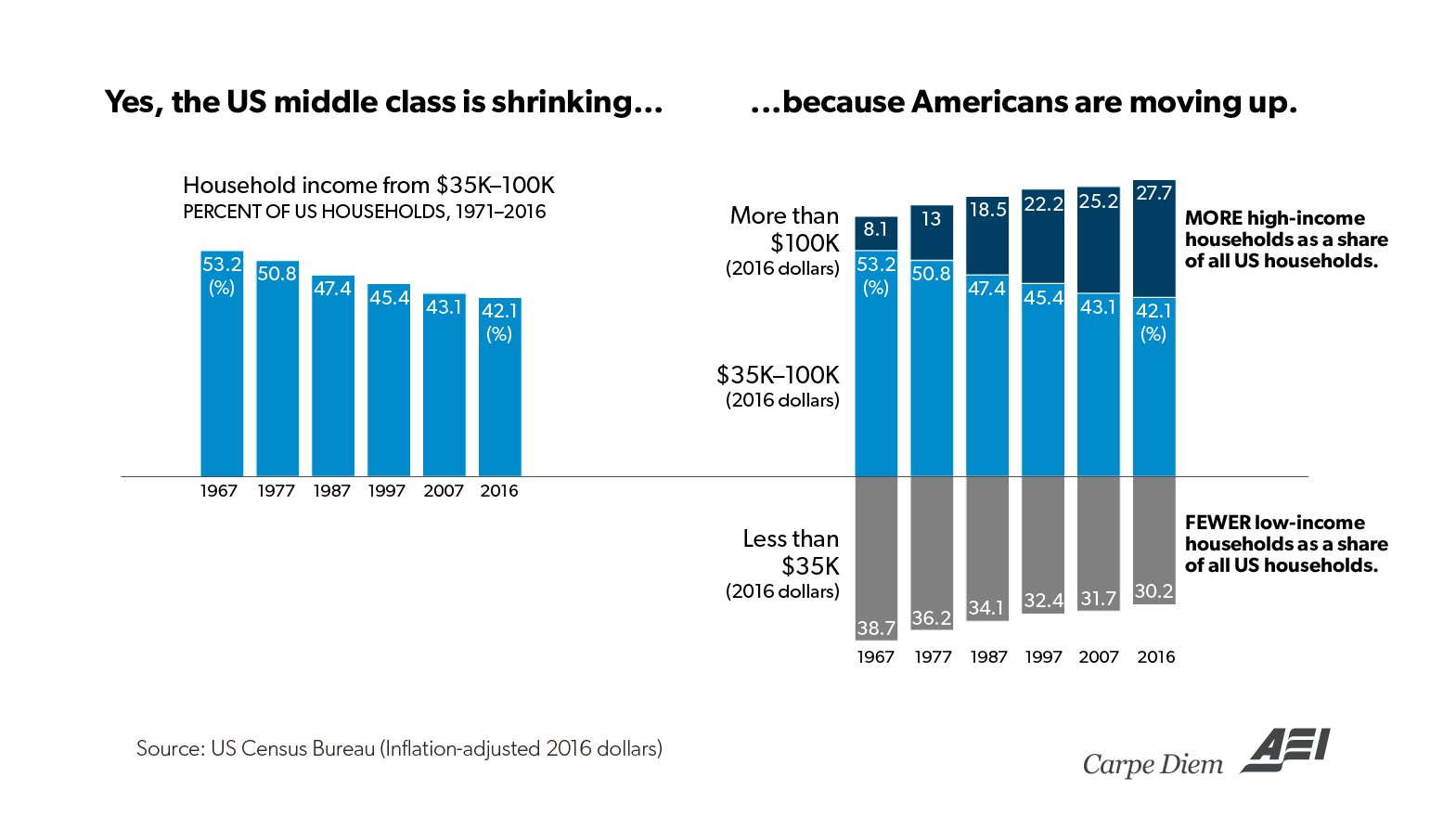January 8th, 2020 at 12:02 pm
Image of the Day: Lowest-Wage Industries Benefit Most Under Trump
From the official federal Bureau of Labor Statistics and our friends at the American Enterprise Institute (AEI), a nice visualization of how the Trump economic agenda has most benefited those in the lower-wage industries starting in 2018 after tax reform took effect. So much for leftists’ class warfare attacks on tax cuts and deregulation.

A Trump Bump
August 19th, 2019 at 10:09 am
Image of the Day: Middle Class Shrinking… In a Good Way
From AEI, something to remember when we’re told that the middle class in America is disappearing. It’s disappearing because people are moving upward:
.

Middle Class Disappearing… Upward
.
February 28th, 2017 at 1:51 pm
Image of the Day: Education Spending Has Skyrocketed, Educational Performance Has Stagnated
Courtesy of the American Enterprise Institute (AEI), educational spending has actually skyrocketed over recent decades, yet educational performance has stagnated:

Education Spending Up, Performance Stagnant
Something to forward whenever someone claims that education spending has somehow been starved, or that insufficient funding is the source of our problems.
June 12th, 2012 at 2:20 pm
Colleges and Car Dealerships
Following on to Tim’s excellent post earlier this week about the cost of higher education, this observation by the American Enterprise Institute’s Norman Ornstein bears noting:
Colleges have become a bit like car dealers, where the sticker price does not reflect the actual cost to most buyers. Some can afford to pay the full boat, helping the colleges maintain their budgets, while others can get deep discounts.
And colleges, under this theory, keep their prices up to match their competitors because a lower tuition would be seen by many prospective students and parents as a reflection of lower quality compared to their peers.
Many economists also point out that federal subsidies for higher education are themselves a contributing factor in increasing college costs.
The economic prescription for reforming higher ed is the same that could be applied to health care, k-12 education, or any other sector of the economy that is co-mingled with the government: greater price transparency, fewer subsidies, lower barriers to entry, and more competition. This isn’t terribly complex stuff. In fact, it should be intuitive to anyone who’s ever studied basic economics. Alas, the dismal science is about the only component of a college education that’s not getting a fair shake these days.
May 17th, 2012 at 3:41 pm
The Case for Green Jobs: America Should be More Like Bankrupt Countries
At a time when Spain is in the news because it lingers on the edge of a full-blown economic meltdown, it’s instructive to remember that this is the country that’s supposed to be the model for the green jobs revolution that President Obama continually claims will help revitalize the American economy. Over at The Blaze, the American Enterprise Institute’s Kenneth Green looks at the factual case and finds it far from compelling:
Now, to the empirical evidence. When talking about our bold green energy future, President Obama held up Spain as an example of what America should be doing. Spain invested heavily in wind power and other types of renewable energy. Alas, after studying the Spanish Experience, Professor Gabriel Calzada Álvarez and colleagues at Spain’s Universidad Rey Juan Carlos found if America followed Spain’s example, for every renewable energy job that the U.S. managed to create, the U.S. should expect a loss of at least 2.2 traditional jobs on average. And they found that green jobs are costly: each green job created in Spain’s effort cost about $750,000, and only one in 10 of the new green jobs were permanent. Doing the math on that, creating even 3 million new green jobs would cost $2.25 trillion. Even in a time where the trillion is the new billion, that’s a lot of money.
Indeed it is. But the money isn’t the real issue. Any “jobs plan” that entails a net loss in jobs shouldn’t be taken seriously by anybody, let alone the President of the United States. If green jobs really are the future of the economy, then sufficient market demand will arise to compel their creation. If, as is far more likely, they are simply a progressive fantasy financed at taxpayer expense, they deserve to have their grip on the public purse shaken as abruptly as possible.
November 6th, 2010 at 4:42 pm
Economics & Finances Might Be Sciences, If It Weren’t for People
Alex Pollock’s contribution in The American, a publication for the American Enterprise Institute (AEI), is much needed medicine for the regulatory fever about to be unleashed when the Dodd-Frank “financial reform” bill is implemented.
The key to understanding boom-and-bust cycles, according to Pollock, is realizing the limits of a mathematical model’s ability to predict the future. To quote Pollock quoting a colleague, “The model works until it doesn’t.” That is, until someone falsifies the model by acting in a way contrary to the model’s assumptions. Then everybody who uses the model is out a lot of money.
So, if profit-hungry businesses can’t figure out a way to avoid losing money, what in the world makes the denizens on Capitol Hill think they can create a federal agency with such powers?
Hubris and stupidity. Political cultivation of those qualities is a science unto itself.
Weekend Bonus Link: For another theory of the business cycle, click here.




 CFIF Freedom Line Blog RSS Feed
CFIF Freedom Line Blog RSS Feed CFIF on Twitter
CFIF on Twitter CFIF on YouTube
CFIF on YouTube